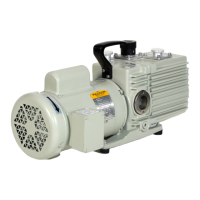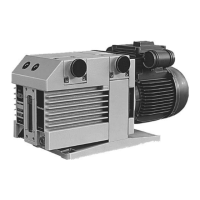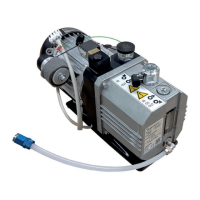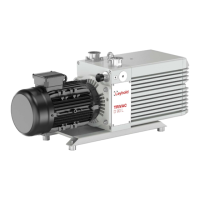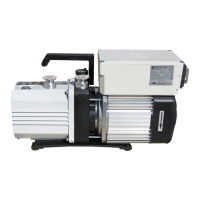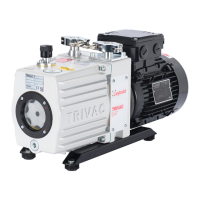TABLE 4-1. TECHNICAL
DATA
\f/
Pump Model
D2A
D4A
DBA
D1GA
D30A
D60A
D90A
Displacement
....
CFM
2.2
4.5
7.0
14.1 26.8 36.7 53.7
Displacement
....
I
iters/minute
62.5
127 190
400
760
1030
1520
Ultimate
partial pressure+ t
....
Torr
3 x
10-
4
3 x
10-
4
3 x
10-
4
3 x
10-
4
3 x
10-
4
3 x
10-
4
3 x
10-
4
Ultimate
pressure
with
gas
ballast +
....
Torr
3 x
10-
3
3 x
10-
3
3 x
10-
3
3 x
10-
3
3,x
10-
3
5 x
10-
3
5 x
10-
3
Water vapor
tolerance
....
Torr
30 15 30
15
40
20 20
Oil
Capacity.
,
.....
quarts
(hydrocarbon)
0.5
0.75
1
1.25
3.5
4
4
...
Ibs
(perfluoropolyether)
2.5
3
4.2
5
13.7
16.8
16.8
Motor
power
....
hp
1/3
1/3
1 1 1·1/2
2.0 3.0
Pump rotational
speed
....
RPM
1725
1725 1725
1725 1725 1150
1725
Weight
complete
....
Ib
41
45 80
85
163
210
210
Sound
pressure level (max) at three feet
with
gas
ballast closed
....
dB(A)
50
50 60 62 59
60
60
Sound pressure level (ave) at three feet
with
gas
ballast open
....
dB(A)
54
56
57
60
62 63·
63
Intake tube and exhaust
port
diameter
....
mm
KF'16
KF'16
KF
*25
KF'25
KF*40
KF'40
KF*40
.
Maximum
ambient
temperature
104°F
(40°C)
t The ultimate pressure + of pumps filled with perfluoropolyether fluid
is
9 x
10-
4
Torr
except for 50-Hz D60A pump models. The
ultimate pressure of
D60A pumps with perfluoropolyether fluid and with 50-Hz motors is 3 x 10-
3
Torr.
+
The
"ultimate partial pressure"
is
measured
with
an
LN2 trapped ionization
gauge.
The
"ultimate
pressure
with
gas
ballast"
is
measured
with a Kammerer Type McLeod Compression
Gauge.
Both
of
these
pressures
can
be,as
much
as
a
decade
higher
When.
measured
with a thermal conductivity
gauge.
* KF - Leybold quick assembly clamp ring diameter.
4-3-2 Changing
the
Pump
Fluid
12
WARNING:
IF
THE PUMP HAS BEEN USED
ON
CORROSIVE, TOXIC, OR VOLATILE CHEMICALS, OBSERVE
PROPER SAFETY
PRECAUTIONS BEFORE REMOVING THE PLUG SCREW
(8).
CAUTION: HYDROCARBON PUMP FLUID SHOULD BE CHANGED
ATTHE
FOLLOWING TIMES:
(a)
AFTER
A
100-HOUR BREAK-IN PERIOD OF PUMP OPERATION,
(b)
WHEN THE PUMP FLUID
IS
CONTAMINATED
(see
Section 4-3-3), (c) WHEN CONDENSATION
IN
THE PUMP FLUID
IS
SEVERE (see Section 4-2), AND
(d)
BEFORE
AND AFTER THE PUMP
IS
STORED FOR A LENGTHY PERIOD (see Section 4-3-4). PERFLUOROPOL YETHER
FLUID SHOULD BE RECONDITIONED WHEN IT BECOMES CONTAMINATED.
NOTE:
Always change the pump fluid while the pump is warm
to
prevent condensables from remaining
in
the pump.
Turn the pump off and change the fluid as
follows:
1.
Ensure
that
the
pump
is
turned
off; then place
an
appropriate container under one of the oil drain ports
to catch the used pump fluid.
2.
If a negative pressure exhaust system is attached to the exhaust line of the pump, disconnect it.
NOTE: A negative exhaust pressure prevents the pump fluid from draining completely.
3.
SEE THE
SECTION
4-3-2 WARNING-Using an 8 mm allen wrench, unscrew and remove the
plug screw (8)
from
one
of
the
oil drain ports and allow the
fluid
to
drain
from
the pump (See
Figure
1-1).
4. When the
flow
of
fluid
slows,
briefly
switch the pump ON and OFF
to
drain the remaining fluid.
5.
Using an 8-mm allen wrench, reinstall the plug screw (8)
with
flat gasket (9)
into
the oil drain
port.
TRIVAC
"A"
Manual,
Edition L
